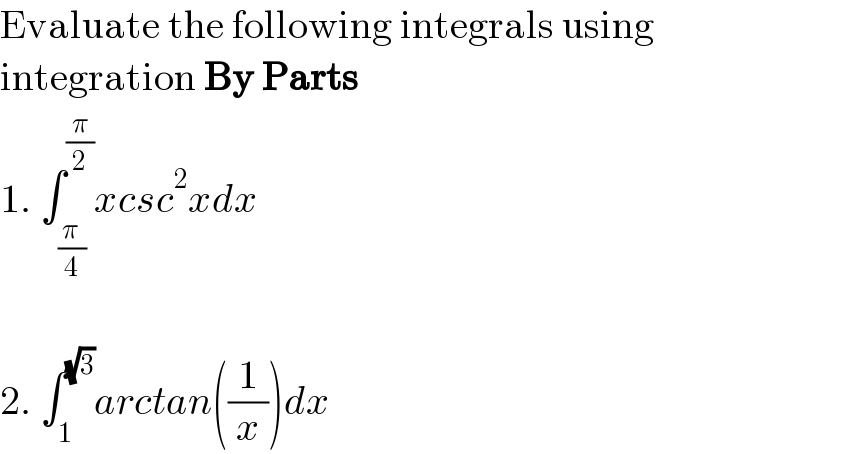
Question Number 158839 by EbrimaDanjo last updated on 09/Nov/21

$$\mathrm{Evaluate}\:\mathrm{the}\:\mathrm{following}\:\mathrm{integrals}\:\mathrm{using} \\ $$$$\mathrm{integration}\:\boldsymbol{\mathrm{By}}\:\boldsymbol{\mathrm{Parts}} \\ $$$$\mathrm{1}.\:\int_{\frac{\pi\:}{\mathrm{4}}} ^{\frac{\pi}{\mathrm{2}}} {xcsc}^{\mathrm{2}} {xdx} \\ $$$$ \\ $$$$\mathrm{2}.\:\int_{\mathrm{1}} ^{\sqrt{\mathrm{3}}} {arctan}\left(\frac{\mathrm{1}}{{x}}\right){dx} \\ $$
Answered by gsk2684 last updated on 09/Nov/21
![∫_(π/4) ^(π/2) x cosec^2 x dx =[x∫ cosec^2 x dx−∫( (d/dx)x)(∫cosec^2 x dx)dx]_(π/4) ^(π/2) =[x∫ cosec^2 x dx−∫(1)(−cot x)dx]_(π/4) ^(π/2) =[x(−cot x)+∫cot xdx]_(π/4) ^(π/2) =[−x cot x+log sin x]_(π/4) ^(π/2) =[−(π/2) cot (π/2)+log sin (π/2)] −[−(π/4) cot (π/4)+log sin (π/4)] =[−(π/2) (0)+log 1] −[−(π/4)(1)+log (1/( (√2)))] =[0+0] −[−(π/4)−log (√2)] = (π/4)+log (√2)= (π/4)+log 2^(1/2) = (π/4)+(1/2)log 2 .......gsk...India....](Q158845.png)
$$ \\ $$$$\underset{\frac{\pi}{\mathrm{4}}} {\overset{\frac{\pi}{\mathrm{2}}} {\int}}{x}\:\mathrm{cosec}^{\mathrm{2}} {x}\:{dx} \\ $$$$=\left[{x}\int\:\mathrm{cosec}^{\mathrm{2}} {x}\:{dx}−\int\left(\:\frac{{d}}{{dx}}{x}\right)\left(\int\mathrm{cosec}\:^{\mathrm{2}} {x}\:{dx}\right){dx}\underset{\frac{\pi}{\mathrm{4}}} {\overset{\frac{\pi}{\mathrm{2}}} {\right]}} \\ $$$$=\left[{x}\int\:\mathrm{cosec}^{\mathrm{2}} {x}\:{dx}−\int\left(\mathrm{1}\right)\left(−\mathrm{cot}\:\:{x}\right){dx}\underset{\frac{\pi}{\mathrm{4}}} {\overset{\frac{\pi}{\mathrm{2}}} {\right]}} \\ $$$$=\left[{x}\left(−\mathrm{cot}\:{x}\right)+\int\mathrm{cot}\:{xdx}\underset{\frac{\pi}{\mathrm{4}}} {\overset{\frac{\pi}{\mathrm{2}}} {\right]}} \\ $$$$=\left[−{x}\:\mathrm{cot}\:{x}+\mathrm{log}\:\:\mathrm{sin}\:{x}\underset{\frac{\pi}{\mathrm{4}}} {\overset{\frac{\pi}{\mathrm{2}}} {\right]}} \\ $$$$=\left[−\frac{\pi}{\mathrm{2}}\:\mathrm{cot}\:\frac{\pi}{\mathrm{2}}+\mathrm{log}\:\:\mathrm{sin}\:\frac{\pi}{\mathrm{2}}\right] \\ $$$$\:\:\:\:−\left[−\frac{\pi}{\mathrm{4}}\:\mathrm{cot}\:\frac{\pi}{\mathrm{4}}+\mathrm{log}\:\:\mathrm{sin}\:\frac{\pi}{\mathrm{4}}\right] \\ $$$$=\left[−\frac{\pi}{\mathrm{2}}\:\left(\mathrm{0}\right)+\mathrm{log}\:\:\mathrm{1}\right]\: \\ $$$$\:\:\:\:−\left[−\frac{\pi}{\mathrm{4}}\left(\mathrm{1}\right)+\mathrm{log}\:\:\frac{\mathrm{1}}{\:\sqrt{\mathrm{2}}}\right] \\ $$$$=\left[\mathrm{0}+\mathrm{0}\right]\:−\left[−\frac{\pi}{\mathrm{4}}−\mathrm{log}\:\sqrt{\mathrm{2}}\right] \\ $$$$=\:\frac{\pi}{\mathrm{4}}+\mathrm{log}\:\sqrt{\mathrm{2}}=\:\frac{\pi}{\mathrm{4}}+\mathrm{log}\:\mathrm{2}^{\frac{\mathrm{1}}{\mathrm{2}}} \\ $$$$=\:\frac{\pi}{\mathrm{4}}+\frac{\mathrm{1}}{\mathrm{2}}\mathrm{log}\:\mathrm{2} \\ $$$$ \\ $$$$\:\:\:\:\:\:\:\:\:\:\:\:\:\:\:\:\:.......{gsk}...{India}.... \\ $$
Answered by puissant last updated on 09/Nov/21
![K=∫_1 ^(√3) arctan((1/x))dx IBP → { ((u=arctan((1/x)))),((v′=1 )) :} ⇒ { ((u′=((−(1/x^2 ))/(1+(1/x^2 ))))),((v=x)) :} ⇒ K=[xarctan((1/x))]_1 ^(√3) +∫_1 ^(√3) (x/(1+x^2 ))dx ⇒ K={(√3)arctan(((√3)/3))−(π/4)}+(1/2)[ln(1+x^2 )]_1 ^(√3) ⇒ K= (((√3)π)/6)−(π/4)+ln2 ∴∵ K = π(((√3)/6)−(1/4))+ln2.. .................Le puissant................](Q158849.png)
$${K}=\int_{\mathrm{1}} ^{\sqrt{\mathrm{3}}} {arctan}\left(\frac{\mathrm{1}}{{x}}\right){dx}\: \\ $$$${IBP}\:\rightarrow\:\begin{cases}{{u}={arctan}\left(\frac{\mathrm{1}}{{x}}\right)}\\{{v}'=\mathrm{1}\:\:\:}\end{cases}\:\Rightarrow\:\begin{cases}{{u}'=\frac{−\frac{\mathrm{1}}{{x}^{\mathrm{2}} }}{\mathrm{1}+\frac{\mathrm{1}}{{x}^{\mathrm{2}} }}}\\{{v}={x}}\end{cases} \\ $$$$\Rightarrow\:{K}=\left[{xarctan}\left(\frac{\mathrm{1}}{{x}}\right)\right]_{\mathrm{1}} ^{\sqrt{\mathrm{3}}} +\int_{\mathrm{1}} ^{\sqrt{\mathrm{3}}} \frac{{x}}{\mathrm{1}+{x}^{\mathrm{2}} }{dx} \\ $$$$\Rightarrow\:{K}=\left\{\sqrt{\mathrm{3}}{arctan}\left(\frac{\sqrt{\mathrm{3}}}{\mathrm{3}}\right)−\frac{\pi}{\mathrm{4}}\right\}+\frac{\mathrm{1}}{\mathrm{2}}\left[{ln}\left(\mathrm{1}+{x}^{\mathrm{2}} \right)\right]_{\mathrm{1}} ^{\sqrt{\mathrm{3}}} \\ $$$$\Rightarrow\:{K}=\:\frac{\sqrt{\mathrm{3}}\pi}{\mathrm{6}}−\frac{\pi}{\mathrm{4}}+{ln}\mathrm{2} \\ $$$$ \\ $$$$\:\:\:\:\:\:\:\:\:\:\:\:\:\:\:\:\therefore\because\:\:\:\:\:\:{K}\:=\:\pi\left(\frac{\sqrt{\mathrm{3}}}{\mathrm{6}}−\frac{\mathrm{1}}{\mathrm{4}}\right)+{ln}\mathrm{2}.. \\ $$$$ \\ $$$$\:\:\:\:\:\:\:\:\:\:\:\:\:\:\:.................\mathscr{L}{e}\:{puissant}................ \\ $$
